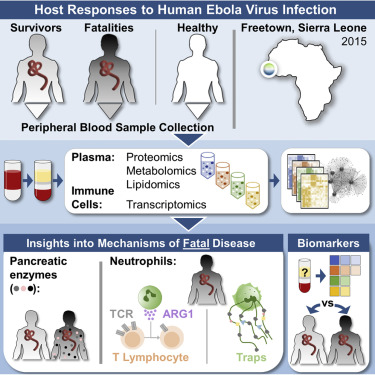Cell Host & Microbe ( IF 30.3 ) Pub Date : 2017-11-16 , DOI: 10.1016/j.chom.2017.10.011 Amie J. Eisfeld , Peter J. Halfmann , Jason P. Wendler , Jennifer E. Kyle , Kristin E. Burnum-Johnson , Zuleyma Peralta , Tadashi Maemura , Kevin B. Walters , Tokiko Watanabe , Satoshi Fukuyama , Makoto Yamashita , Jon M. Jacobs , Young-Mo Kim , Cameron P. Casey , Kelly G. Stratton , Bobbie-Jo M. Webb-Robertson , Marina A. Gritsenko , Matthew E. Monroe , Karl K. Weitz , Anil K. Shukla , Mingyuan Tian , Gabriele Neumann , Jennifer L. Reed , Harm van Bakel , Thomas O. Metz , Richard D. Smith , Katrina M. Waters , Alhaji N'jai , Foday Sahr , Yoshihiro Kawaoka

|
The pathogenesis of human Ebola virus disease (EVD) is complex. EVD is characterized by high levels of virus replication and dissemination, dysregulated immune responses, extensive virus- and host-mediated tissue damage, and disordered coagulation. To clarify how host responses contribute to EVD pathophysiology, we performed multi-platform ’omics analysis of peripheral blood mononuclear cells and plasma from EVD patients. Our results indicate that EVD molecular signatures overlap with those of sepsis, imply that pancreatic enzymes contribute to tissue damage in fatal EVD, and suggest that Ebola virus infection may induce aberrant neutrophils whose activity could explain hallmarks of fatal EVD. Moreover, integrated biomarker prediction identified putative biomarkers from different data platforms that differentiated survivors and fatalities early after infection. This work reveals insight into EVD pathogenesis, suggests an effective approach for biomarker identification, and provides an important community resource for further analysis of human EVD severity.
中文翻译:

埃博拉病毒病发病机制的多平台'组学分析
人类埃博拉病毒病(EVD)的发病机理很复杂。EVD的特征是病毒复制和传播水平高,免疫反应失调,病毒和宿主介导的广泛组织损伤以及凝血紊乱。为了阐明宿主反应如何促进EVD病理生理,我们对EVD患者的外周血单核细胞和血浆进行了多平台'组学分析。我们的结果表明,EVD分子特征与败血症的特征重叠,这表明胰腺酶对致命性EVD的组织损伤有贡献,并表明埃博拉病毒感染可能诱导异常嗜中性粒细胞,其活性可以解释致命性EVD的特征。而且,整合的生物标志物预测从不同的数据平台中识别出推定的生物标志物,这些标志物可在感染后早期区分幸存者和死亡人数。这项工作揭示了对EVD发病机理的见解,为生物标志物鉴定提供了一种有效的方法,并为进一步分析人类EVD的严重程度提供了重要的社区资源。



























 京公网安备 11010802027423号
京公网安备 11010802027423号